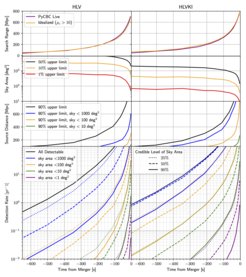Forewarning of Cataclysmic Cosmic Collisions
Scenarios for the Early Detection and Localization of Compact-binary Mergers with Ground-based Observatories
On August 17, 2017, the world observed the collision of two neutron stars. These collisions produce some of the most powerful bursts of energy in the universe. What if we could predict when these will occur? Neutrons stars tug at the fabric of space as they march towards their eventual death sending out gravitational-wave ripples we detect here on earth. Over the next ten years, cutting edge facilities will be able to find and predict the collision of a neutron star binary a minute or more beforehand so that telescopes can observe the cataclysmic moment directly!
Paper abstract
We present the prospects for the early (pre-merger) detection and localization of compact-binary coalescences using gravitational waves over the next 10 yr. Early warning can enable the direct observation of the prompt and early electromagnetic emission of a neutron star merger. We examine the capabilities of the ground-based detectors at their “Design” sensitivity (2021–2022), the planned “A+” upgrade (2024–2026), and the envisioned “Voyager” concept (late 2020s). We find that for a fiducial rate of binary neutron star mergers of 1000 Gpc−3 yr−1, the Design, A+, and Voyager era networks can provide 18, 54, and 195 s of warning for one source per year of observing, respectively, with a sky localization area <100 deg2 at a 90% credible level. At the same rate, the A+ and Voyager era networks will be able to provide 9 and 43 s of warning, respectively, for a source with <10 deg2 localization area. We compare the idealized search sensitivity to that achieved by the PyCBC Live search tuned for pre-merger detection. The gravitational-wave community will be prepared to produce pre-merger alerts. Our results motivate the operation of observatories with wide fields of view, automation, and the capability for fast slewing to observe simultaneously with the gravitational-wave network.













